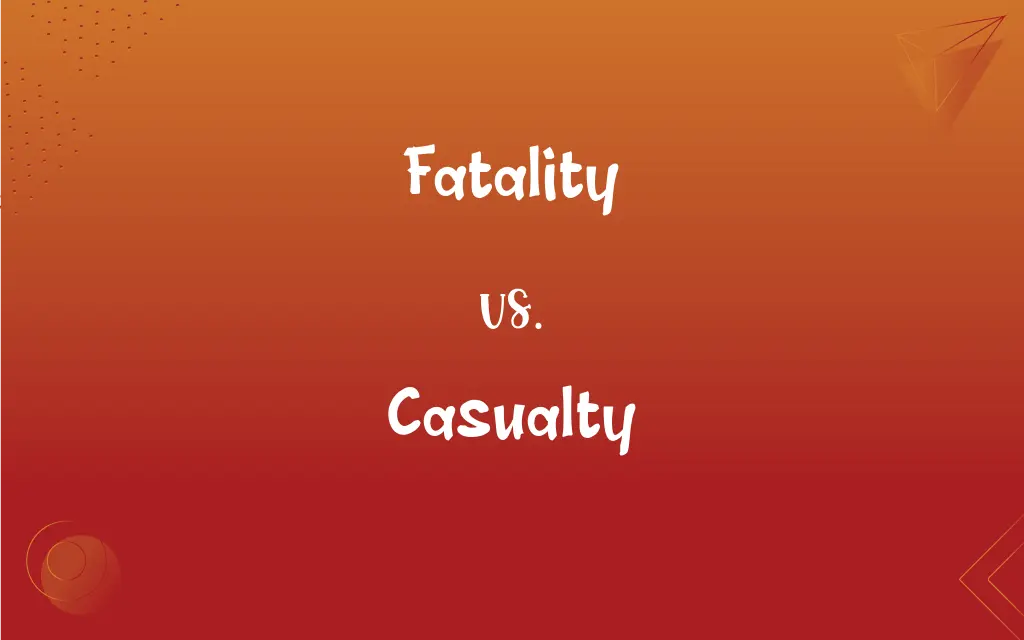Fatality vs. Casualty: What's the Difference?
By Harlon Moss & Janet White || Updated on March 3, 2024
Fatality emphasizes death resulting from an accident or disaster, whereas casualty can include both deaths and injuries in such events.

Key Differences
Fatality is specifically used to refer to deaths resulting from accidents, diseases, or disasters. It underscores the severity and finality of the outcome. On the other hand, casualty is a broader term that encompasses not just fatalities but also injuries and sometimes even those who are missing as a result of accidents, wars, or natural disasters.
In the context of accidents or disasters, a fatality count gives a stark measure of the lives lost. It is a critical metric in understanding the direct human cost. Whereas, casualty figures provide a more comprehensive view of the incident's impact, including both those who have lost their lives and those who have been injured or otherwise affected.
When reporting on conflicts or military engagements, fatalities are often highlighted to underscore the lethality of the encounter. In contrast, casualty numbers are used to convey the overall human toll, which can influence public perception and policy decisions.
In medical and emergency response planning, understanding fatality rates is crucial for assessing the potential lethality of diseases or the effectiveness of safety measures. Meanwhile, casualty rates are important for planning resource allocation and response strategies to manage both the injured and the dead.
In legal and insurance contexts, distinguishing between fatalities and casualties can have implications for compensation, benefits, and liability. Fatalities may trigger specific legal outcomes and settlements, whereas casualties might lead to different types of claims or legal considerations.
ADVERTISEMENT
Comparison Chart
Definition
Death caused by an accident or disaster
Death or injuries caused by an accident or disaster
Scope
Only includes deaths
Includes deaths, injuries, and sometimes missing persons
Context Usage
Emphasized in severe accidents, diseases, and disasters
Used broadly in accidents, wars, and disasters
Impact on Reporting
Highlights the severity and finality
Provides a comprehensive view of the human toll
Relevance in Planning
Crucial for assessing lethality
Important for resource allocation and response strategies
ADVERTISEMENT
Fatality and Casualty Definitions
Fatality
The lethal outcome of a hazardous situation.
The fatality of the storm was unprecedented.
Casualty
A person killed or injured in a war or accident.
The battle had many casualties.
Fatality
A term often used in legal and insurance documents to denote death.
The report listed three fatalities from the incident.
Casualty
The total number of deaths and injuries in an event.
The earthquake's casualty count rose by the hour.
Fatality
The final and irreversible consequence in extreme situations.
The expedition faced a fatality when one member did not return.
Casualty
A term used in military contexts to describe losses.
The regiment suffered heavy casualties.
Fatality
The occurrence of death in an accident or disaster.
The car crash resulted in one fatality.
Casualty
In medical contexts, a casualty department is where emergencies are treated.
She was rushed to the casualty ward after the accident.
Fatality
A statistic representing a death in specific contexts, such as public health.
The disease had a high fatality rate.
Casualty
Casualty can also refer to a serious accident itself.
The train derailment was a major casualty.
Casualty
One who is injured or killed in an accident
A train wreck with many casualties.
Casualty
One who is injured, killed, captured, or missing in action through engagement with an enemy
Battlefield casualties were high.
Casualty
One that is harmed or eliminated as a result of an action or circumstance
The corner grocery was a casualty of the expanding supermarkets.
Casualty
An accident, especially one involving serious injury or loss of life.
Casualty
Something that happens by chance, especially an unfortunate event; an accident, a disaster.
Casualty
A person suffering from injuries or who has been killed due to an accident or through an act of violence.
Casualty
(proscribed) Specifically, a person who has been killed (not only injured) due to an accident or through an act of violence; a fatality.
Casualty
(military) A person in military service who becomes unavailable for duty, for any reason (notably death, injury, illness, capture, or desertion).
Casualty
(British) The accident and emergency department of a hospital providing immediate treatment; a casualty department or emergency room.
Casualty
An incidental charge or payment.
Casualty
Someone or something adversely affected by a decision, event or situation.
Casualty
(obsolete) Chance nature; randomness.
Casualty
That which comes without design or without being foreseen; contingency.
Losses that befall them by mere casualty.
Casualty
Any injury of the body from accident; hence, death, or other misfortune, occasioned by an accident; as, an unhappy casualty.
Casualty
Numerical loss caused by death, wounds, discharge, or desertion.
Casualty
Someone injured or killed or captured or missing in a military engagement
Casualty
Someone injured or killed in an accident
Casualty
An accident that causes someone to die
Casualty
A decrease of military personnel or equipment
FAQs
Why is it important to distinguish between fatalities and casualties in reporting?
Distinguishing between fatalities and casualties is important for accurately conveying the human impact of an event and for informing appropriate response and policy decisions.
How are fatality rates calculated in public health?
Fatality rates in public health are calculated by dividing the number of deaths by the total number of confirmed cases of a disease, often expressed per 100 or 1000 individuals.
Is a missing person considered a casualty?
A missing person can be considered a casualty in contexts such as military conflicts or large-scale disasters, where the status of individuals is uncertain.
Can a casualty be someone who is not injured or dead?
Typically, casualties refer to those who are dead or injured, but it can sometimes include missing persons in certain contexts.
What defines a fatality in an accident?
A fatality in an accident is defined as a death that occurs as a direct result of the incident.
Can fatality rates vary significantly between different diseases?
Yes, fatality rates can vary significantly between diseases, depending on factors like virulence, availability of treatment, and population immunity.
What is the difference between a casualty ward and a regular hospital ward?
A casualty ward is specifically designed for emergency treatment and immediate care of injuries or conditions, unlike regular wards that manage a broader range of medical needs.
What psychological effects can high casualty rates have on a population?
High casualty rates can have profound psychological effects on a population, including grief, trauma, and heightened fear or anxiety about safety.
How do insurance companies use fatality statistics?
Insurance companies use fatality statistics to assess risks, set premiums, and determine coverage terms for life, health, and property insurance policies.
Can improvements in emergency services reduce casualty figures?
Yes, improvements in emergency services can significantly reduce casualty figures by providing faster and more effective response and medical treatment to injured individuals.
How do fatality figures influence public policy?
Fatality figures can influence public policy by highlighting the severity of issues like public health crises or road safety, prompting legislative or infrastructural changes.
In what way do fatality and casualty figures impact humanitarian aid?
Fatality and casualty figures impact humanitarian aid by determining the urgency, scale, and type of aid required, such as medical supplies, search and rescue teams, or support for displaced persons.
How do fatality and casualty rates affect public perception of safety?
High fatality and casualty rates can affect public perception by creating a sense of danger associated with certain activities, places, or policies, potentially leading to demands for change.
What is the significance of tracking casualty trends over time?
Tracking casualty trends over time is significant for identifying patterns, assessing the effectiveness of safety measures, and forecasting future risks.
How might a high fatality rate influence research and development in healthcare?
A high fatality rate might accelerate research and development efforts in healthcare to find better treatments, vaccines, or preventive measures against diseases or conditions causing the deaths.
Are all casualties in a military conflict from combat?
Not all casualties in a military conflict are from combat; they can also include non-combat injuries, accidents, and diseases.
What role do casualty figures play in disaster management?
Casualty figures play a critical role in disaster management by indicating the scale of an emergency, guiding resource allocation, and prioritizing rescue and medical efforts.
What distinguishes a fatality from a natural cause of death?
A fatality often implies a sudden or unexpected death due to an external cause (like an accident or disaster), whereas a natural cause of death results from health-related issues without external intervention.
Why might a business be concerned with fatality and casualty rates?
Businesses might be concerned with fatality and casualty rates for reasons such as workplace safety, insurance liabilities, and compliance with health and safety regulations.
How do news reports typically distinguish between fatalities and casualties?
News reports typically specify fatalities as deaths and use the term casualties to encompass both deaths and injuries for clarity and accuracy in conveying the impact of an event.
About Author
Written by
Harlon MossHarlon is a seasoned quality moderator and accomplished content writer for Difference Wiki. An alumnus of the prestigious University of California, he earned his degree in Computer Science. Leveraging his academic background, Harlon brings a meticulous and informed perspective to his work, ensuring content accuracy and excellence.
Co-written by
Janet WhiteJanet White has been an esteemed writer and blogger for Difference Wiki. Holding a Master's degree in Science and Medical Journalism from the prestigious Boston University, she has consistently demonstrated her expertise and passion for her field. When she's not immersed in her work, Janet relishes her time exercising, delving into a good book, and cherishing moments with friends and family.































































